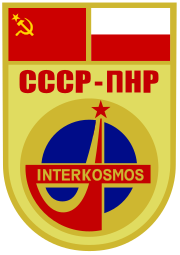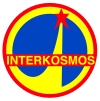Soyuz 30
The Soyuz 30 capsule, Hermaszewski's spacesuits and personal items, as well as memorabilia from the flight on display. | |
| COSPAR ID | 1978-065A |
|---|---|
| SATCAT no. | 10968 |
| Mission duration | 7 days, 22 hours, 2 minutes, 59 seconds |
| Orbits completed | 125 |
| Spacecraft properties | |
| Spacecraft type | NPO Energia |
| Launch mass | 6,800 kilograms (15,000 lb) |
| Crew | |
| Crew size | 2 |
| Members | Pyotr Klimuk Mirosław Hermaszewski |
| Callsign | Кавказ (Kavkaz - "Caucasus") |
| Start of mission | |
| Launch date | 27 June 1978, 15:27:21 UTC |
| Rocket | 1/5[1] |
| End of mission | |
| Landing date | 5 July 1978, 13:30:20 UTC |
| Landing site | 300 kilometres (190 mi) W of Tselinograd |
| Orbital parameters | |
| Reference system | Geocentric |
| Regime | Low Earth |
| Perigee altitude | 197.6 kilometres (122.8 mi) |
| Apogee altitude | 261.3 kilometres (162.4 mi) |
| Inclination | 51.66 degrees |
| Period | 88.83 minutes |
| Docking with Salyut 6 | |

Soyuz programme (Crewed missions) | |
Soyuz 30 (Russian: Союз 30, Union 30) was a 1978 crewed Soviet space flight to the Salyut 6 space station. It was the sixth mission to and fifth successful docking at the orbiting facility.[2] The Soyuz 30 crew were the first to visit the long-duration Soyuz 29 resident crew.
Soyuz 30 carried
Crew
| Position | Cosmonaut | |
|---|---|---|
| Commander | EP-3 Third and last spaceflight | |
| Research Cosmonaut | EP-3 Only spaceflight | |
Backup crew
| Position | Cosmonaut | |
|---|---|---|
| Commander | ||
| Flight Engineer | ||
Mission parameters
- Mass: 6,800 kg (15,000 lb)
- Perigee: 197.6 km (122.8 mi)
- Apogee: 261.3 km (162.4 mi)
- Inclination: 51.66°
- Period: 88.83 minutes
Mission highlights

The second
The activities of the Soyuz 30 crew, however, were severely curtailed so as not to interfere with the Soyuz 29 crew. On the Soyuz 29 crew's rest day, the international crew had to stay in their Soyuz to perform their experiments.
The Soyuz 30 crew was trained, as all international crews, in the use of the MKF-6M camera. Training in part took place on a
Hermaszewski participated in medical experiments which measured lung capacity and the heart during exercise and in a pressure suit. One experiment, which all four on board the station participated in, was Smak (the Polish word for taste), a taste experiment which sought answers to why some food was less palatable in weightlessness.[4]
The Soyuz 30 crew packed their experiments into their capsule and returned to Earth 5 July, landing in a Rostov state farm field 300 km west of
See also
References
- ^ "Baikonur LC1". Encyclopedia Astronautica. Archived from the original on 2009-04-15. Retrieved 2009-03-04.
- ^ The mission report is available here: http://www.spacefacts.de/mission/english/soyuz-30.htm
- ^ ISBN 0-517-56954-X.
- ^ ISBN 0-87201-848-2.







